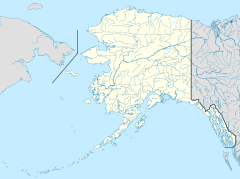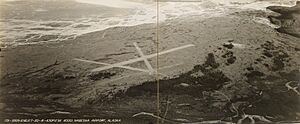Nabesna, Alaska facts for kids
Quick facts for kids
Nabesna
Nabaesna’ / Naambia Niign Daacheeg
|
|
|---|---|
| Nabesna | |
| Country | United States |
| State | Alaska |
| Census area | Copper River |
| Area | |
| • Total | 160.82 sq mi (416.51 km2) |
| • Land | 160.26 sq mi (415.06 km2) |
| • Water | 0.56 sq mi (1.45 km2) |
| Elevation | 2,979 ft (908 m) |
| Population
(2020)
|
|
| • Total | 2 |
| • Density | 0.01/sq mi (0.00/km2) |
| Time zone | UTC-9 (Alaska (AKST)) |
| • Summer (DST) | UTC-8 (AKDT) |
| FIPS code | 02-51960 |
| GNIS feature ID | 1406770 |
|
Nabesna Gold Mine Historic District
|
|
| Location | Base of White Mountain at end of Nabesna Road |
|---|---|
| Area | 330.6 acres (133.8 ha) |
| Built | 1926 |
| Built by | Carl F. Whitham |
| NRHP reference No. | 79003755 |
| Significant dates | |
| Added to NRHP | April 26, 1979 |
Nabesna is a very small community in northern Alaska, United States. It is known as a census-designated place, which is a special area defined by the government for counting people. The community is located inside the beautiful Wrangell-St. Elias National Park and Preserve.
Nabesna sits at the end of the Nabesna Road, a gravel road that connects it to another road called the Tok Cut-Off. It is found at the base of White Mountain, part of the Wrangell Mountains. The community was named after the Nabesna Mining Company, which started it. In 1909, it even got its own post office. According to the 2020 census, only two people live there now.
Contents
History of Nabesna
Gold Discovery and Mining Operations
Gold was first found at White Mountain in 1891. The area started to be developed for mining in the early 1900s. A person named Carl Whitham helped create the Nabesna Mining Company in 1929. This led to the mining camp growing and the building of the Nabesna Road.
The mine had to close during World War II. It opened again for a short time after the war. However, it closed for good when Carl Whitham passed away in 1947. During its active years, the mine produced a lot of gold. It also produced many tons of silver, copper, and lead.
Nabesna as a Historic Site
After the mine closed, the old mining camp became a ghost town. A ghost town is a place where most people have left. In 1979, this old mining camp and the mine were recognized as the Nabesna Gold Mine Historic District. This means they are important historical sites. They were added to the National Register of Historic Places.
During the Cold War, the United States Army used the location as a secret place to store supplies.
Population Changes
| Historical population | |||
|---|---|---|---|
| Census | Pop. | %± | |
| 1930 | 54 | — | |
| 1940 | 23 | −57.4% | |
| 1950 | 28 | 21.7% | |
| 2010 | 5 | — | |
| 2020 | 2 | −60.0% | |
| U.S. Decennial Census | |||
Nabesna first appeared in the U.S. Census in 1930 as a small mining village. At that time, 54 people lived there. The population changed over the years. By 2010, it was listed as a census-designated place with 5 residents. In 2020, the population was 2 people. This shows how small the community has become.
Climate in Nabesna
Nabesna has a continental subarctic climate. This means it has very cold and long winters. The summers are usually short and cool. It can get very cold, with temperatures often below freezing for many months.
See also
 In Spanish: Nabesna (Alaska) para niños
In Spanish: Nabesna (Alaska) para niños



